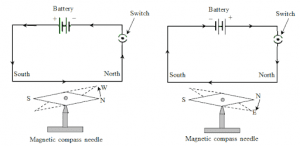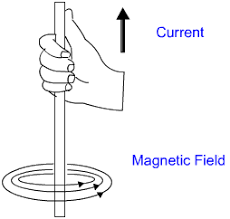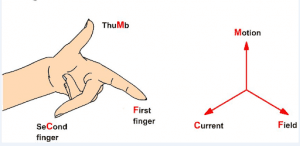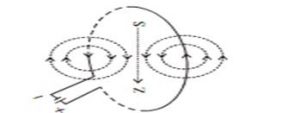Magnetic Effects of Electric Current- Science Class 10th
The theory of the magnetic effect of electric current was discovered by H.C Oersted in 1820. This concept actually shows that the flow of an electric current through a conductor produces a magnetic field around it. The magnetic effect of current can be demonstrated by the following experiment (Oersted experiment).
First, make a simple electric circuit by joining a straight wire connected to a battery and a plug. Now, take a compass needle and place the straight wire parallel to and over the compass needle. Switch on the circuit so that the current flows through the wire from South to North directions. Now, we will observe that the magnetic compass needle gets averted towards the west. But, if we reversed the direction of the current from North to South pole the magnetic compass gets averted towards the East.
According to the SNOW rule, when the current flows through a conductor from South to North direction and a magnetic compass is placed over the wire then the needle of the compass deflects towards west.

Edignite helps you focus on history and explanation of the magnetic effect of electric current class 10.
The Basic Concepts
- Electric Current: It is a flow of electric charge past a point or region.
- Magnetic field: It is the area around the magnet where the magnetic force is experienced. The imaginary lines of the magnetic field around a magnet is called Magnetic Field Lines.
- Electro-Magnetic(EM) Field: An EM field is a combination of electric and magnetic fields This is produced when electrically charged particles, such as electrons are accelerated and surrounded by electric fields. These charged particles when in motion generate a magnetic field.
So, the magnetic effect of electric current is defined as the electromagnetic (EM) effect. It means when a magnetic compass is brought near an electrically charged conductor then the needle of this compass gets deflected because of the flow of electricity.
Explanation of Magnetic Effect of Electric Current
Edignite provides you comprehensive notes on the magnetic effect of electric current class 10 with proper images.
-
The Right-hand Thumb rule
The Right-Hand Thumb rule (Maxwell’s Corkscrew ) is a convenient way of finding the direction of the magnetic field associated with a current-carrying conductor.
As per Right-Hand Thumb rule, if a current-carrying conductor is held by the right hand such that thumb points towards the direction of current then the direction of the magnetic field can be depicted by the direction of folded fingers.


This means, in a vertical current-carrying conductor if the direction of the current is from south to north then the magnetic field will be in an anticlockwise direction. But, if the direction of current is flowing from north to south then the magnetic field will be in a clockwise direction.
- The flow of current through a circular loop

Like in the Right-Hand Thumb rule if the electric carrying conductor is circular-shaped instead of a straight current conductor the magnetic field is generated in the same manner. This is because the current-carrying conductor exerts a force when a magnetic needle is placed near it. Similarly, a magnet also exerts equal and opposite pressure on the electric carrying conductor. Here it should be observed that with the change in direction of the flow of current the force of the magnet on the conductor also changes (by SNOW rule).
In a circular loop, the strength of the magnetic field will be high because the magnetic field is very close to the current-carrying conductor.
-
Fleming’s Left-Hand Rule

According to Fleming’s Left-Hand Rule, if the direction of the flow of current is perpendicular to the magnetic field, the direction of its force is also perpendicular to it. Stretch thumb, forefinger, and middle finger of your left hand such that they are mutually perpendicular to each other. It states that forefinger and middle finger represents the direction of the magnetic field and electrical fields. The thumb represents the direction of motion or force acting on the current carrying conductor. The directions of electric, magnetic field and force are similar to three mutually perpendicular axes, i.e. x,y, and z-axes.
Application of Fleming’s Left-Hand Rule in Electric Motor
The working electric motor is a good example of how Fleming’s Left-hand rule works, Electrical energy is converted into mechanical energy by using an electric motor. In an electrical motor, a rectangular coil is suspended between the two poles – North and South of a magnetic field. The electric supply to the coil is connected to the commutator, a device that reverses the direction of the flow of current through a circuit.
When a current is supplied to the coil of the electric motor, it gets deflected because of the magnetic field. As it reaches the halfway, the spit ring which acts as a commutator reverses the direction of the flow of electric current. When the direction of the current reverses the direction of forces acting on the coil also gets reversed. Thus the change in direction of force pushes the coil and moves another half turn. Finally, the coil completes its one rotation around the axle and the continual process keeps the motor in a rotation motion.
Click here for more concepts of class 10 science. Revise these notes and save your time during stressful exam days. All the best!
Tag:effect of magnetic field on current, electric current, electro magnetic field, emf, fleming left hand, fleming right hand, Fleming right hand rule, flemings left hand rule, magnetic effects, Magnetic Effects of Electric Current, magnetic effects of electric current class 10, magnetic effects of electric current class 10 science, Oersted experiment




